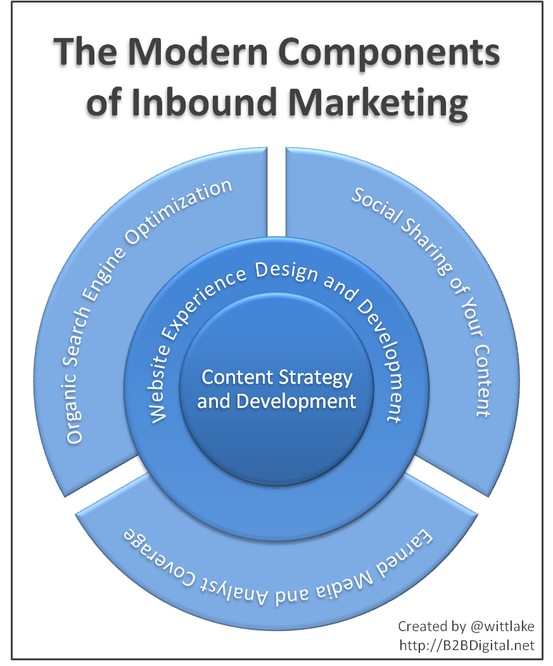Last week, I made the case for a new definition of inbound marketing, or as Michael Brenner (@brennermichael) called it in the comments, a “call to arms” for inbound marketers.
The new definition: Inbound marketing is marketing focused on being found through the recommendation of others and delighting everyone that finds you.
As inbound marketing evolves, the components also need to change. Traditionally, inbound marketing has been functionally defined as the combination of search, social and content. However, these components are not enough for inbound marketers to excel in today’s environment.
This is what modern inbound marketing looks like:
 Source: b2bdigital.net via Eric on Pinterest
Source: b2bdigital.net via Eric on Pinterest
1. Content Is at the Core
Content strategy and development is core to inbound marketing. Your content is what makes finding you valuable. It is what others recommend. Without great content strategy and development, your inbound marketing program is not sustainable.
2. The Experience Wraps Your Content
If content is the steak, the experience you wrap around the content gives it the sizzle. To delight everyone that finds your content the overall experience must delight. People don’t recommend your content, they recommend the complete experience, including your content.
Personally, I am less likely to share an article through social media if it is on a site that is covered with garish ad units or is always popping up subscribe forms. The content may be valuable, but the experience is degraded.
3. Organic Search Engine Optimization
Organic search results are the search engine algorithm’s recommendation of the best result for a search. It is a valuable recommendation that continues to drive traffic as long as you maintain it. In contrast, paid search is merely an indication you have the budget and skill to run a paid search program. It is valuable, but it isn’t inbound marketing.
According to Shareaholic, organic search traffic from Google, Yahoo and Bing accounted for 51.6% of all traffic in February 2012. If search engine optimization seems like more than you can tackle, here is a practical approach to SEO you can easily apply.
I ignored search as a traffic source for B2B Digital Marketing yet I have seen organic search traffic significantly outpace social media traffic, where I did invest time, in recent months.
4. Social Sharing of Your Content
When other people share your content, and the experience surrounding it, they are recommending it. These recommendations are the social component of inbound marketing and they must be earned with the content and experience you create.
Sharing your own content is not a recommendation. You have merely picked up your social media bullhorn for the modern equivalent of an email blast. Everyone shares their own content, even their bad content. Like paid search, it is valuable, but it isn’t inbound marketing.
5. Public Relations
Journalists or analysts may not directly recommend your product, but when they cite your research, practices or case studies, they are indicating that what you are producing is worth reading, considering or discussing.
In addition to blogger outreach (often included because of inbound marketing’s connection to social media), recommendations through press, analyst and media relations should be on nearly every inbound marketer’s agenda.
In Summary
Modern inbound marketing is built around the core of your content and the experience it is wrapped in. This content and experience is discovered through organic search, other people’s social media recommendations and earned coverage from media, analysts and other publishers.
Your Turn
In the spirit of inbound marketing, if you enjoyed this article or feel this view of the key components of inbound marketing warrants discussion, share it!
As always, I welcome your feedback in the comments below or share your perspective with me on Twitter (@wittlake).